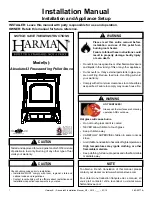
4
VITAE FS V2
– 22-4-16
3
Installation Instructions
READ THESE INSTRUCTIONS CAREFULLY BEFORE INSTALLATION
It is very important to understand the requirements of the National Building Regulations (England
and Wales – Document J / Scotland - Part F/Document J (Republic of Ireland only) and standards BS
8303, BS 6461, BS 7566, along with any local regulations and working practices that may apply.
Should any conflict occur between these instructions and these regulations then the regulations must
apply.
Health and Safety Precautions
Works must be carried out with care to meet the requirements of Health and Safety (Health and
Safety at Work Act 1974) and comply with the Health and Safety rules contained therein, and any
new regulations introduced during the lifetime of these instructions.
Handling
Adequate facilities must be available for unloading and site handling. Heat Design Cassette Stoves are very
heavily built so always ask for assistance when lifting and siting the stoves.
Fire Cement
Some types of fire cement are caustic and should not be allowed to come into contact with the skin. In case
of skin contact, wash immediately with plenty of water.
Asbestos
This stove contains no asbestos. If there is a possibility of disturbing any asbestos in the course of
installation then please seek specialist guidance and use appropriate protective equipment.
Metal Parts
When installing or servicing this stove, proper care should be taken to avoid the possibility of personal
injury.
Important Chimney Warning
This stove must not
be installed into a chimney that serves any other heating appliance.
Extractor Fan Warning
There must not be an extractor fan fitted in the same room as the stove as this can cause the stove to emit
fumes into the room. Ref doc J in building regulations.
Cleaning and Chimney Sweeping
The appliance, flue & chimney must be cleaned and checked internally and externally regularly in use
and especially after a period on disuse (e.g. after summer).
Lift down the baffle regularly to check for
build up of soot or debris on the top from the flue pipe. Remove the baffle and check the flue spigot and
connector is fully clear at regular intervals. The chimney and flue connector must be swept at least annually,
more often when used with sooty fuels or damp wood. Any loose, broken or leaking joints or flue ways
MUST be repaired immediately.
Fuels
Only use recommended fuels. The appliance can be damaged by burning petroleum coke, liquid fuels or
general rubbish and this will invalidate your warranty and risk your personal safety.
The appliance must
not be used as a rubbish incinerator
.




































